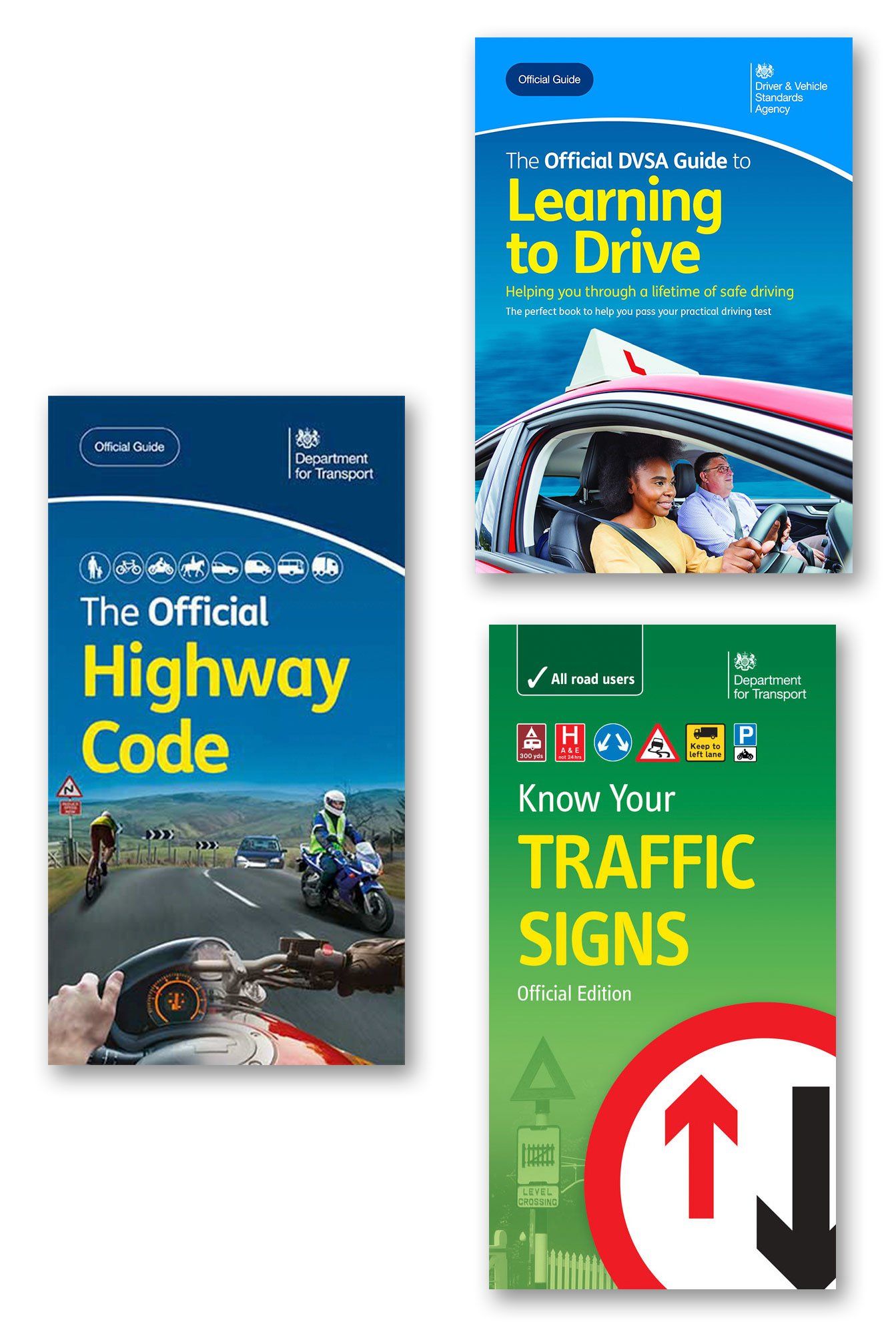USEFUL INFO
Information on the theory test
Ok, once you've got your provisional licence you will need to start thinking about taking your theory driving test. This consists of a multiple-choice section and a hazard perception test.
Both test are taken at the same time, you will need to pass both parts to pass.
My recommended learning App is Driving Test Success approx £5.
The multiple-choice section is presented with a touch screen computer. You will need to answer all 50 questions; you will need to get 43 correct in order to pass. With the hazard perception test, your responses are recorded through the use of a computer mouse button. You must click as early as possible when you see a developing hazard with a maximum of 5 points per hazard. There are a total of fifteen developing hazards giving a possible total of 75 points. You must score at least 44 in order to pass.
Remember: if you fail one test you will have to retake both parts again. Practice makes perfect ensure you take plenty of mock tests in both parts before taking the real thing.
Recommended reading material
This is great it goes where you go so you can read anywhere, any time, any place. This and the Learning to Drive book are available from Amazon.co.uk.
- Know your traffic signs book (free PDF)
This information will be invaluable to you leading up to your practical driving test.
Practical Driving Test
According to the DSA "those who pass their driving test had had on average about 45 hours of professional training combined with 22 hours of private practice".
It is important for you to be at a competent level before embarking on a practical test.
Always book your practical test through the DSA.Gov.uk website, I will be advising you on the best test centre for you this usually is the one closest to where you live. Ideally you are going to try and avoid tests during busy periods of the day, i.e, morning rush hour and school pick up times. Ideally a test shoud be booked between 10am and 1.30pm. Most tests are taken Monday- Friday. Some test can be taken at weekends if necessary. You will be having an hour lesson before the test to allow you to warm up and practice a little and to try and get rid of your nerves.
On the day
Okay so the big day is here - remember your driving examiner will be observing you for an overall high safe standard of driving.
You must arrive at the test centre at your allotted time, turning up over five minutes late will result in your test being cancelled by the examiner.
The test will start with your eyesight test (you must be to read a car number plate at around four car lengths away) again failure to do this will result in the test being cancelled.
You will then be asked two safety questions (see safety questions). Failure to do this won't fail you but you want the examiner to feel like you are ready to take this test, ready to pass and be able to look after your car whilst on the road. If you get them wrong you will pickup a driver fault.
This day is when all the information you have learnt over the pass few months (highway code, theory test, traffic signs etc. come into play, failure to understand or forget is not an option. I want you to be a safe confident driver for the rest of your life.
The driving part of your test will last for around 40 minutes. Most pupils use my car for their practical test although some do take it in their own, I will be happy which ever you feel most confident in.
If you take it in your own car I will ensure that it conforms to the test vehicle requirements set by the DSA. Some vehicles can't be used for safety reasons.
SOME REASONS WHY YOU COULD FAIL YOUR TEST
- Failing to bring both parts of your driving licence to test
- Turning up late for test
- Unable to read a car licence plate at around 4 car lengths
- Turning up on the wrong date
1 ) Acting improperly at road junctions
A common reason for a test fail is going over the give way or stop lines. Stopping over the line is considered to be dangerous. Approaching junctions too fast and lack of observations. Remember your MSPSL routine every time; watch out for other vehicles and pedestrians.
2) Manoeuvre - reversing around the corner.
This is one manoeuvre that most of my pupils hate, you need to prove to the examiner that you have control of your vehicle, you are accurate and take good all around observations frequently (every 3-4 seconds). It is important to keep at an appropriate speed (remember crawling on your hands and knees) preparing to give way and pause/stop for other vehicles if necessary. You must stay close to the kerb without touching it, try to stay a steering wheels distance from the kerb. Remember to keep checking over your right shoulder.
3) Failure to make proper use of steering.
Remember to feed the steering wheel through your hands. Don't cross your hands on the wheel or let the wheel spin back after a turn or drive with hands off the wheel for any longer than they have to be. Use the steering wheel gently and smoothly.
4) Manoeuvre - problems with parking
Again a tricky manoeuvre, proving to the examiner that you have good control, accuracy and observations. Keep the vehicle slow, use the reference points I've taught you, observe other vehicles, pedestrians, cyclists and stop if they approach. Remember to check over your right shoulder every 3-4 seconds.
5) Failure to make proper use of gears.
Make sure you are in the correct gear for the speed you are travelling at. Remember to always move off in 1st gear. As a general rule change to 2nd at 15mph, 3rd at 25mph, 4th at 40mph and 5th At 50mph. Downhill - 5mph up hill +5 i.e. 2nd at 20/25mph.
6) Failure to make proper use of your mirrors
Under use of your mirrors is a common mistake. Remember to check your mirrors when changing speed, any direction, when signalling, turning into a new road, changing lanes or travelling down a straight road (every 7 seconds) if you see a hazard remember to use your mirrors and slow down.
7) Driving at incorrect speed
Driving too slowly is seen as a sign of the driver lacking confidence but it can also be dangerous and frustrating for other road user as it may cause them to make unsafe actions such as overtaking. Use of appropriate speed is very important. If the road your on is clear driver at the speed limit or appropriate speed and not unnecessarily slow. Keep a good look out for speed changes.
Equally driving too fast is extremely hazardous. Keep to the speed limit if you go over don't panic and slam on your brakes, ease off gas quickly and readjust your speed if you need to brake do so gently.
8) Acting incorrectly when turning right.
Remember to use your MSPSL routine correctly. Judging the correct amount of time too turn can be tricky, imagine yourself as a pedestrian and only proceed with your vehicle if you felt as a pedestrian you could walk safely from one side of the road to the other.
Make sure you don't cause any vehicles to slow down, swerve of stop whilst you are emerging. Make sure your vehicle is positioned just left of centre and follow all road markings allowing traffic to undertake you if the road is wide enough.
9) Hesitating unnecessarily at junctions.
Try not to take too much caution when emerging from a junction; imagine you are the pedestrian as above. Avoid approaching junctions too fast. Don't take risks! Remember right left right as a minimum observation and don't forget to peep and creep if you have parked cars obscuring your view.
10) Moving off incorrectly
When moving off remember your 6 point check routine, check rear view mirror again and signal if necessary just before moving off. If it's not safe don't move wait until it's safe.
11) Poor eyesight
Silly as it may sound but plenty of people fail before even getting in the car. Ensure your eyesight is good and you can read a car number plate around 4-5 car lengths distance away.
12) Incorrect documentation
You must bring with you on your theory and practical both parts of you driving licence (card and paper part). Other useful documents are theory certificate Nd your letter of test appointment.
13) Signalling incorrectly
Remember signalling is letting other road users know what we are planning to do. Signal correctly and time the signal well and in plenty of time without misleading other road users.
APPLYING FOR YOUR LICENCE
Provisional driving licence
Applying for your provisional is your first step if you have not done so yet. You will need to complete the DVLA's D1 application form which is available online or at your local post office. Or if you prefer to apply online, you can
do so on the Direct Gov website. You can apply for you provisional licence up to 3 months before you 17th birthday although you cannot dive on the road until you have turned 17 and you have your provisional licence in
your possession.
Before applying for a driving licence make sure you:
- are a resident of the UK
- can meet the minimum age requirement
- can meet the minimum eyesight requirement
- are currently not prevented from driving for any reason
- can pay £50 by Master Card, Visa, Maestro, Electron, Delta or
Solo debit or credit card - have a valid UK passport or another form of identity
- can provide addresses of where you have lived for the past
3 years.
The DVLA will aim to send your driving licence within 10 working days of you submitting your application.
Full driving licence
Once you've passed your practical test your examiner will ask to take your provisional licence and have your full licence sent to you by post, this usually takes around 14 working days. Your examiner will issue you with a pass certificate, which means you can now drive straight away, but you must keep the certificate with you until your new full licence arrives.
If you have use of a vehicle remember you must inform your insurance company that you have passed, as this now will change your insurance policy.


